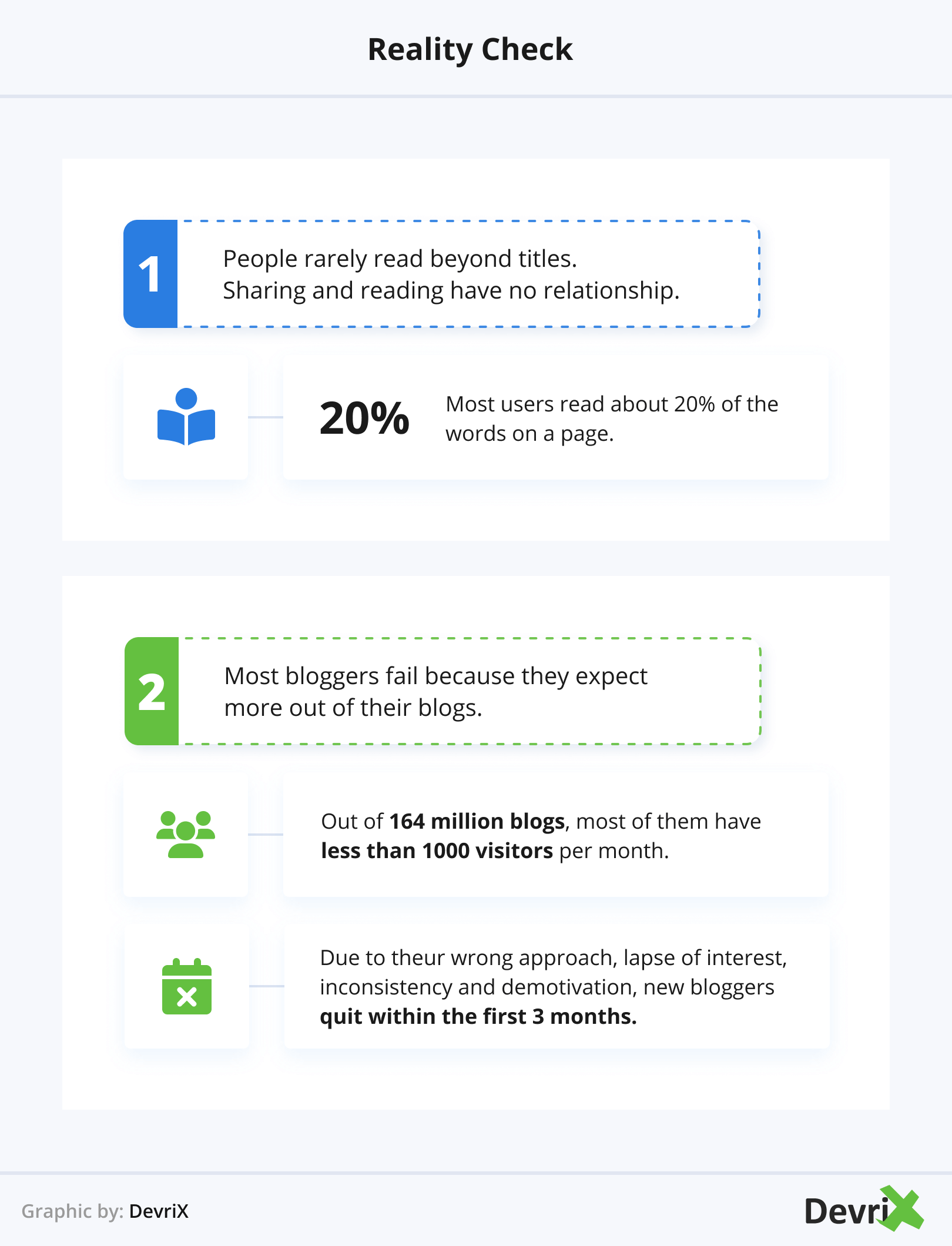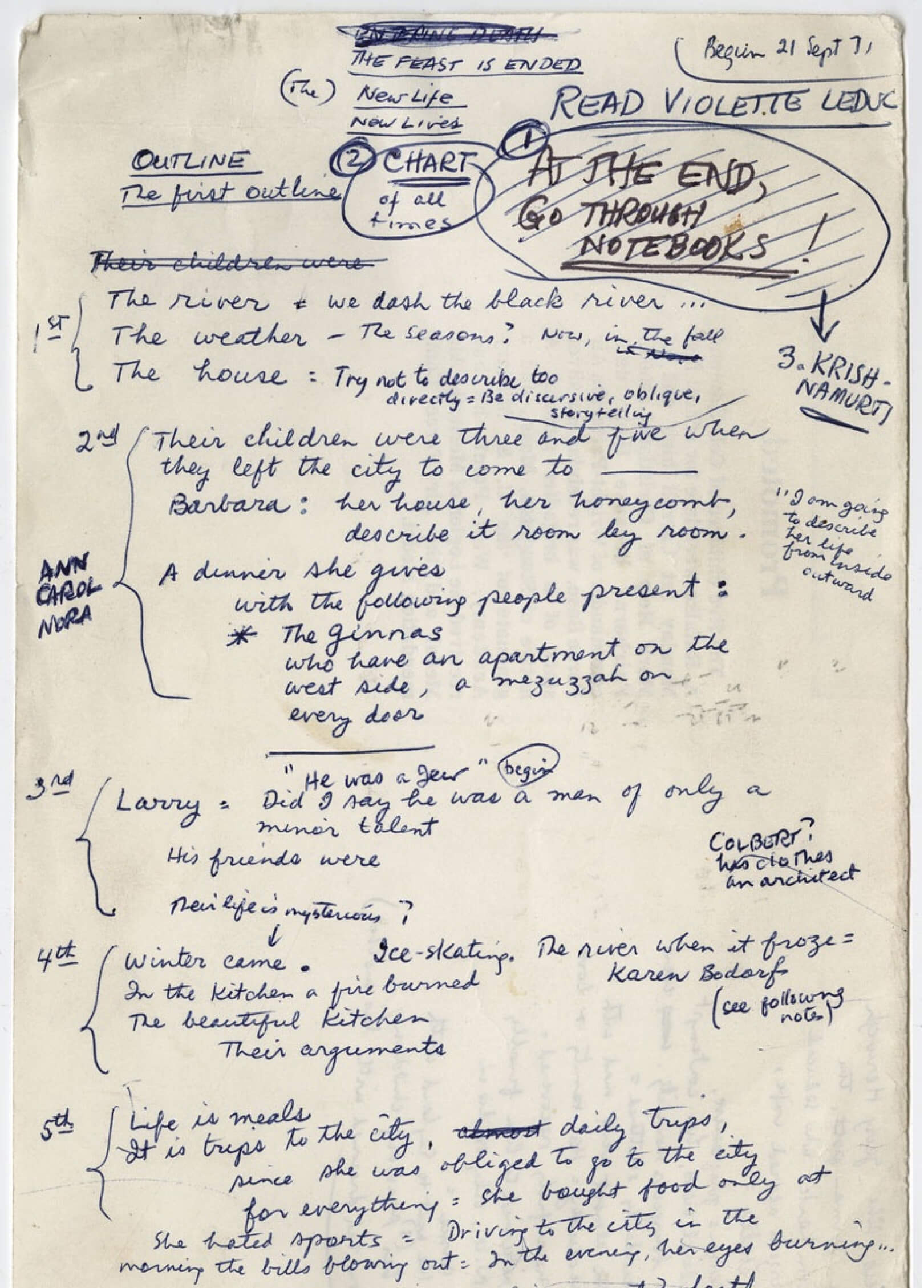It seems complicated to create an article that generates massive web traffic and leads. Besides, a content writer needs to have a foolproof plan and stick to it all the time. Right from coming up with an eye-catching title through to the end, a writer should remain alerted like a mother deer protecting her fawns (readers) from deadly predators (distraction).

So, the question is: “Do you have a perfect plan for writing engaging posts consistently?”
The most important factor that determines a blog’s success is the human psychology.
- Readers expect you to amaze them with jaw-dropping facts and amazing opportunities.
- You expect your blogs to transform your audience’s way of thinking.
Before you skip and move on to the tips, here’s a reality check for your content writing efforts:

We expect too much from our work, put our best efforts into content writing for social media, thinking that other things (like promotions) are not as important as the main content.
These time-wasting attributes lead to the blog’s failure:
- Consuming all your time and efforts on the content.
- Relying on limited social platforms to promote the blog.
- Creating a blog that doesn’t target a particular set of audience.
The balance between content writing and promotion is all that it takes to get the desired results. Not to mention, starters have to be patient to reach a respectable position. Let’s find out what professionals do to create engaging articles.
11 Expert Tips to Create Must-Read Content
Relevant and trendy content is the undisputed king on the internet, and these tips will help you get to the top.
Be Consistent with Research

For a successful blog, you need to keep coming up with fresh content ideas related to your niche. To do that, you need to act like an expert entrepreneur finding ways to spread your brand’s awareness.
Keep your batteries charged and keep learning about the field you’re in, even when you’re not writing. It’ll help increase the quality of your posts.
- Jot Down Ways to Develop Your Ideas. Consistent research always helps to build a strong foundation around your ideas. It is the best way to avoid (or minimize) “type and delete” frustration and will definitely save your time.
As soon as you get an idea, perform your research and start jotting down important points about the topic. Find websites to learn more about the topic. Most often, professional bloggers finish their outline way before sitting and writing the topic. Here is an example:

The basic idea has other supportive ideas that will be used to elaborate on it. Ensure that you’re willing to write them too. This will help you choose the direction of your article and go on with more specific research.
- Gather web resources for reference. In connection to noting down websites, don’t forget to add some of those as your references. These will add value to your post. A professional’s approach is to note down those URLs under the point and add comments to find out why they were added. It will help you write your articles quickly and most of the research would have been completed by the time you sit to write.
1. Write in Your Own Voice
Your own way of content writing is the best way to express your ideas. It’s a skill that keeps on evolving as time passes. Your writing style is your own – a gift that no one else has. The central idea is that you should use your copywriting skills in such a way that you can express your ideas in a better way.

Before we move on, we would like you to check out this amazing post on copywriting and how to do it right.
When starting a new project, the problem that most writers face is to find their own voice.
How Can You Find Your Own Voice?

Your own voice is very important particularly when you’re maintaining a blog. It won’t be long when readers realize that you’re sharing others’ points of view instead of your own.
Professional bloggers and content writers follow a three-step process to come up with articles of their own. These steps are Copy, Mastery, and Innovation.
- In the first phase, read, study and learn how your favorite writers write.
- In the second phase, develop your own unique style based on what you learned.
These guidelines will help you find your own way of writing:
- First, find 5 best content writers whose writings appeal to you: They may or may not be the most popular ones. However, it will be better for you to learn from those who have the ability to attract the masses.
- Next, select some of the best pieces from the posts of each of these writers: Moreover, you may also select articles that you enjoyed reading.
- Choose your favorite writing sample and read it word-for-word: now, read five of the best pieces you’ve chosen and read it thoroughly. You can also add notes on important places so that you can refer to them when you write your own piece.
- Learn how the post was written: keep your focus on the following things:
- The structure of the starting sentence.
- Introduction format.
- Article structure.
- Presentation of ideas.
- Topic development.
- Conclusion.
- Call of action.
Now, it’s your turn To write. Based on what you’ve just learned, write an article or blog post about your brand. Your article should look identical to the one you’ve read in terms of format and structure.
Repeat this exercise for other samples. Now, do it for the rest of the pieces you chose in step1. You’ll end up with 5 different writing pieces for the same brand.
Next, review all of the articles you’ve written. Categorize them in terms of likeness and pick your “Most Favorite One”.
Write another article out of the one you’ve chosen and this time, add more of what you normally would in the article. Make the draft your own and incorporate your own tone.. Make sure your personality comes through the piece of writing. That’s where you create your own writing piece.
Now, do the same with other ones too. In a similar manner, repeat this exercise with other articles that you’ve written in Step 6.
2. Try the “Fishing Net Protocol”
Perrin Carrell of the Authority Hacker team shared a method he uses when writing blog posts. He called it the Fishing Net Protocol.
It’s a technique wherein you gather the sources for your article on Google search using site operators. Then, pick the best five articles from the sources you’ve gathered. After that, you can now proceed to making the outline for your post. Use the sources to come up with the body of the article that you are writing. Don’t forget to add your insights about the topics.
3. Discuss Only One Thing In Every Content You’ve Written
Each piece of writing must contain only one aspect of your brand. The easiest way to do that is to think of the last line (bottom line) at the time you start writing your first sentence.
The bottom line is the “Call to Action”, and the whole article revolves around how your readers should do what you want them to do.
After you finish writing, start with ruthless editing so that your writing sticks to one point.
Edit accordingly if you think the point is irrelevant. Regardless of your likeness, any word, sentence or paragraph that deviates slightly from the topic should be deleted (or perhaps you could save them for future posts).
4. Match Depth With Length
There are two main reasons why people find blog posts difficult to understand or boring. One is too little coverage of the topic that makes it next to irrelevant. In contrast, too much detail can make it hard for them to follow.

Length is not an issue, but you have to clear the topic within the length you have chosen.
- If you’re writing a short article, either give the most important aspect with a high level of discussion or cover one aspect with in-depth detail.
Seth Godin is perhaps one of the best bloggers of short articles. He seldom writes posts that exceed 100 words. In fact. this one has just 47 words.

- If you have a large space, you can dig deep inside to make difficult topics easy to understand.
Crazy Egg and KISSmetrics have posts ranging between 800+ and 2000+ words.
5. Come up With a Unique Angle
The content of the post can be divided into three aspects:
- Topic – the main subject or the point of conversation.
- Point – the idea of what you want to share.
- Slant – the point of view in favor or against the topic.

Writer’s Digest published Adair Lara’s article on this particular topic. The author has given a few great tips to cover an article from different angles.
6. Title Takes a Lot of Time: Spend As Much As You Can
No matter how good your topic is, a bad title can ruin your expectations associated with it. According to David Ogilvy:
“On the average, five times as many people read the headline as read the body copy. When you have written your headline, you have spent eighty cents out of your dollar”
Michael Keene and Maxine Hairston explained 4 significant functions of a good title:
- The title must predict the content.
- It must be catchy.
- It must reflect the slant or tone of writing.
- And it must have keywords.
The making of the title takes a lot of time. Jeff Goins claims that headlines and titles are considered important. Unlike a lot of writers, Jeff consumes 30 – 60 minutes writing headlines.
Here are 9 types of titles that perform well:
- “xx of…” denotesseful or interesting things.
- “Top 5 or top 10 list” that captures a reader’s attention.
- “How to…” shows something interesting and useful.
- “Best of…” caters more to brands,categories,or types.
- “How xx…” focuses on industry leaders/celebrities/brands that your readers want to know.
- “Why xxis…” explains popular trends.
- “An interview with…” a catchy title that offers insights to interviews.
- “Breaking News:…” catches the attention of the reader.
- “Secrets of…” [Something well-known people do that other individuals are dying to know.
7. You Have 3 Seconds to Grab Your Reader’s Attention With the First Sentence

If you think you have done all the hard work, just ask someone to read the first sentence of your topic. Then ask them if that sentence was enticing enough to keep their interest on your topic. If the answer is affirmative, you’ve just won a 3-second battle to take your reader down to the rest of your article. Otherwise, you should create a really interesting sentence.
Take a look at this opening sentence from CopyBlogger, don’t you think you should read more of it?
The opening sentence of your post should give the reader an idea about the main point. At the same time, it must be catchy enough so that they couldn’t resist reading a bit more.
You can start with a question, a quote, something that readers have not heard, or anything that forces their minds into thinking. The moment they start thinking of the sentence, they are hooked.
8. Write an Irresistible Introduction
An introduction is a lead to your subject. It should play like an experienced cold-calling agent in “Wolf of Wall Street” that never takes “No” for an answer.
For a short article, an introduction could be the first paragraph, or at most, the first two paragraphs. For long posts, it could be the first 500 words (3 to 4 paragraphs). If you’re writing a book, then your first chapter will be the introduction.
What kind of introductions do well?
Some popular leads or introductions are as follows:
- A fascinating story.
- Interesting facts.
- Contrarian views.
- Something unique with a promise that it is not available anywhere else.
- Breaking news
You can learn how to write good introductions with the help of the following:
- 6 Steps To Writing Captivating Blog Post
- How to Write a Blog post
- 10 Simple Ways to Write Stronger Introductions
- Here’s How to Write an Introduction
9. Don’t Create Hype; Keep it Reasonable
Do not exaggerate! Don’t stretch your content too much and stay away from the hype.
Your readers don’t have time to read something they don’t trust, or something inaccurate.
Keep your content simple and believable by maintaining a smooth flow of information. If you present anything they don’t know, provide them with proof to support your claim. Add statistics and examples to support the facts you shared in your post.
If you fail to do so, they won’t believe and may not come back.
10. Pay As Much Attention to Closing As You Did With Your Introduction
It depends upon you how you close the article. This is where you can create a difference between good content and a great content. The conclusion of a good content summarizes the details whereas, that of a great content tells “So what”. Adding a bonus tip, extra advice will be helpful.
Magoosh published an article on writing an interesting conclusion. It shares four different types of ineffective conclusions. So, avoid writing any of these types of closing.
Bonus:
Keep Your Writing Plain and Simple
Readers like to read a simple and easy to understand text. So, instead of a hard rocky mountain, your content should look like a plain field. Here’s what you can do:
- Paragraphs should not exceed 6 lines.
- Keep your sentences under 25 words with 1-2 syllables.
- Avoid using fluff.
- Communicate clearly.
- Use the right formatting.
- Outline your ideas.
These things will help keep your readers hooked and remain on your blog for a longer duration. This article also dives into how you can keep your visitors longer.
Killer Editing
No matter how good of a content writer you are, you cannot come up with a finished content without edits. Why waste time while you’re writing? Professionals always spend more time on content after they finish writing – on edits.
Try incorporating the following:
- Be quick to write down your ideas.
- Keep up with your ideas.
- Put your effort into editing.
Conclusion
Great content is not too difficult to create – you just need to be consistent with your effort. The more you learn, the more you discover and adopt, which will help polish your writing skills. Don’t hesitate to bring in something out of the box, then build on the thought until you’re convinced about the idea.
Yes, the exercise takes a bit of time, but once you start doing it regularly, you’ll soon have a treasure of information to share.




